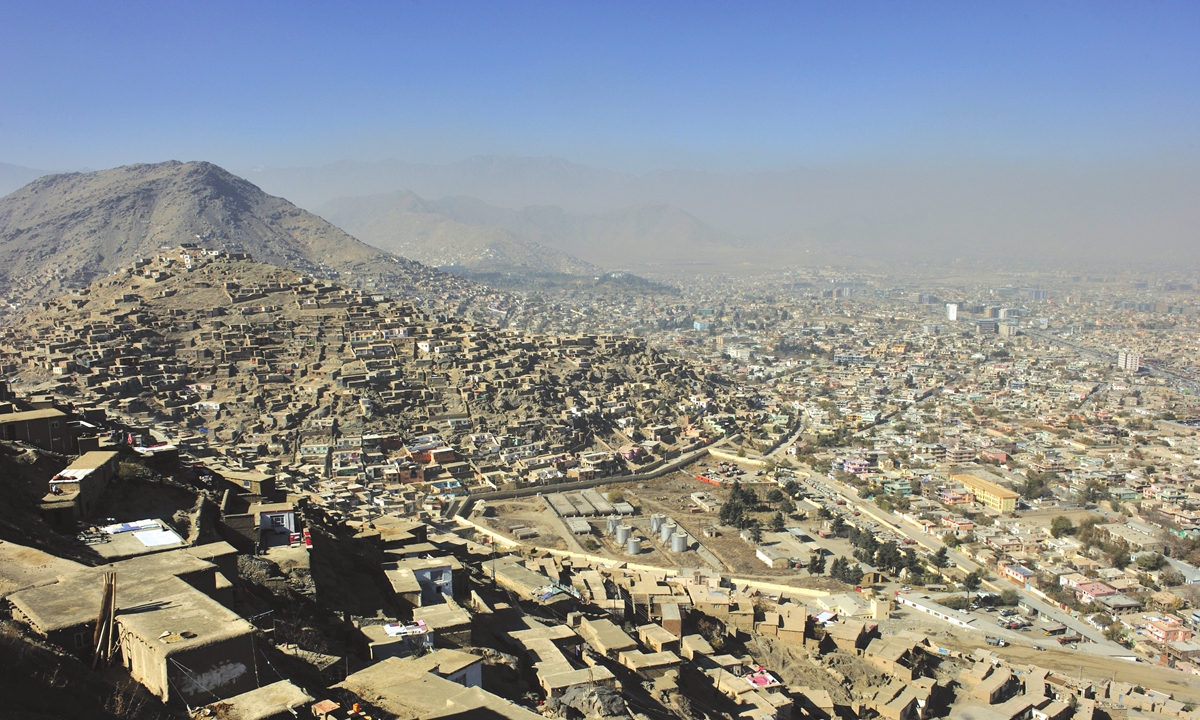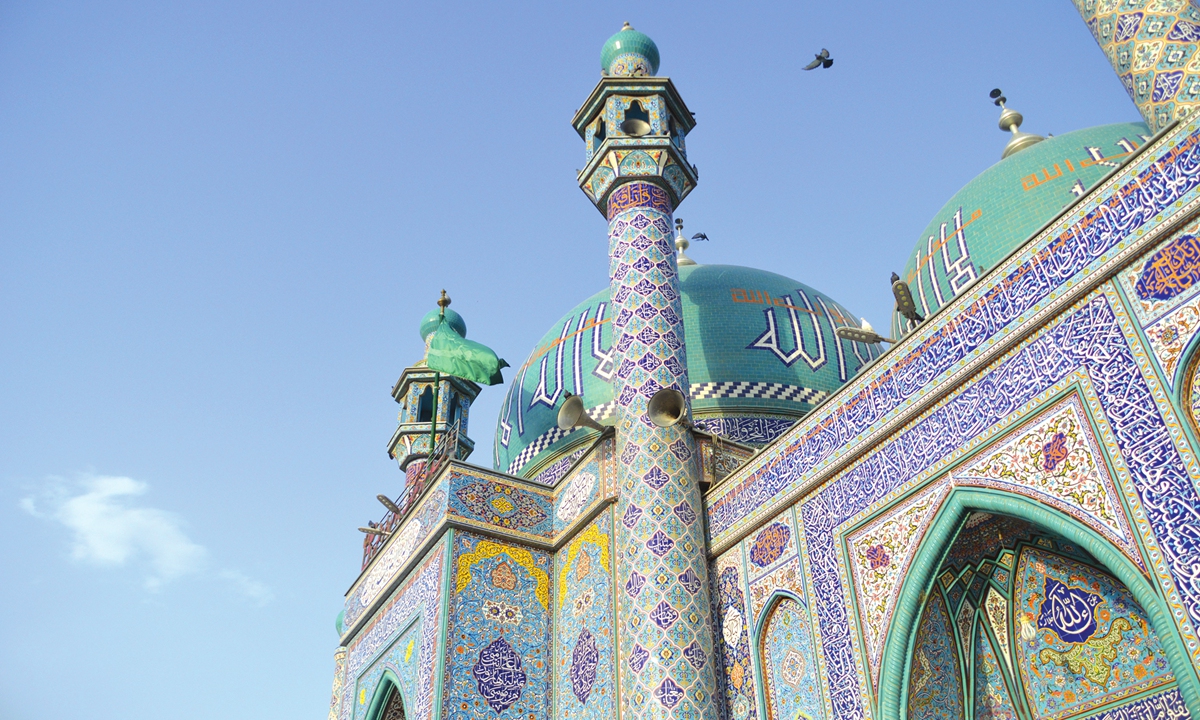Tucked in the Hindu Kush Mountains, Kabul has long been a city of traditional homes - many of them centuries old - made of mud and straw, and others built in the early 1900s, known for their intricate nooks, wooden window frames and luscious gardens.
But, the Afghan capital's architectural heritage is disappearing, architects warn, as many of the old homes are being demolished and replaced with rapidly constructed high-rises to house a boom in new arrivals from rural provinces.

General street views of Kabul, Afghanistan Photos: VCG
"War has destroyed much of our cultural heritage, but we now have to fight an architectural war," said Ferdous Samim, architect and chief executive officer at Taak Inc, an architecture and engineering design firm based in Kabul.
In November, the much-loved Cinema Park - a 70-year-old movie theater - was leveled at the request of first Vice President Amrullah Saleh, despite public outrage and protests from artists, filmmakers and the public. Authorities said the building was structurally unsound.
Years of conflict and economic hardship have driven Afghans from around the country to Kabul in search of a more secure life.
The city has seen an average annual growth rate of nearly 10 percent since the fall of the Taliban in 2001, according to UN-Habitat, the housing and urban development agency.
With no recent census, it is difficult to know how many people live in the Afghan capital, but estimates range between 6 million and 7 million.
"This rapid urban expansion is happening at the expense of traditional, historical homes," Samim said.
Mariam Azimi's family built several large houses with gardens in West Kabul in the 1940s. Today, she said, they are constantly approached by investors hoping to buy the land, tear down the properties and put up new apartment buildings.
"Offers increase when the situation in Afghanistan gets worse, for example when violence is on the rise or ahead of elections," said Azimi, who asked to use a pseudonym for security reasons.
Life in Kabul is becoming increasingly difficult, she explained, and the upkeep of older houses is expensive, so some families choose to sell their land - potentially for millions of dollars - and invest that money overseas.
"Of course, it means that Kabul's character is changing. Old buildings are destroyed. New ones are going up rapidly. The city is barely recognizable," Azimi said.
Kabul's mayor Dawood Sultanzoi told Reuters that "there is no law against progress."
"Historic areas are safeguarded, but if a building is insecure and it cannot be restored, we can't keep it for nostalgia's sake," he added in a phone interview. "If a house has been declared historic, it won't be destroyed."
Unaccounted heritage With unregistered construction rife across the country and many residents mired in long-standing land disputes, there are no estimates of how many historical buildings have been demolished in Kabul.
According to the country's national register of protected monuments, more than 1,300 buildings, mosques and other historical sites have been documented throughout the country. But the number that should be listed is much higher, said Ajmal Maiwandi, chief executive officer at the Aga Khan Trust for Culture.
"There are 184 registered monuments in Kabul alone and the Department of Historic Monuments believes that there are at least twice that number that need to be surveyed and registered in the city in the future," he noted.
The Trust has been working in Afghanistan since 2002, restoring war-damaged quarters of Kabul and historical buildings throughout the country.
"There are no buildings beyond preservation, reconstruction and repair," Maiwandi said from his office, a building from the 1900s with high, ornate ceilings, thick wooden window frames and built-in wood furniture.

General street views of Kabul, Afghanistan
City of changesMaiwandi noted the style and construction methods of the newer buildings in Kabul reflect Afghanistan's evolution into a country torn by war, but also flooded with foreign aid money and a growing population of the newly rich.
"If you examine the political, economic, and security realities and dynamics of the past 20 years, the city is very much a reflection of its time," he said.
Originally, Kabul was filled with walled compounds and houses built around courtyards, with narrow passageways leading to bazaars, mosques and public gardens. The 1920s ushered in a new era under King Amanullah Khan who took to reforming Afghanistan's architecture and advocated for a modernized, open city with many of the walls removed, explained Samim, the architect.
"He didn't touch the old parts of the city. But, during that time, a new city was built that is now considered old," he said.
A new construction boom came after the US-led invasion of Afghanistan in 2001 when people with money returned had fled the country during the Taliban's rule. Fitting the large influx of people into the city has seen single-family homes make way for buildings that house dozens, sometimes even hundreds of families. Up to 80 percent of urban residents live in informal neighborhoods, and insecurity is driving still more people into cities, according to UN-Habitat.
"Most new buildings are neither insulated nor energy efficient, while older ones had been built to endure the harsh weather patterns of hot summers and cold winters," Samim said.
Several homeowners in Kabul told Reuters that when new apartment blocks go up, they often tower over older houses in the area. That has prompted some families to sell their homes, they said.
While Azimi's family is renting one of their houses, she said she hopes her family will be able to keep the house they currently live in. But, it is impossible for them to avoid Kabul's push into modernity, she said.
A new high-rise has gone up right next door to her house, now overlooking her lush, tree-filled garden.
"Of course, the situation gets more difficult and nothing is certain," she said, referring to the recent surge in violence and the unstable political situation in Afghanistan.
"But we have plans. And we'd like to stay."





